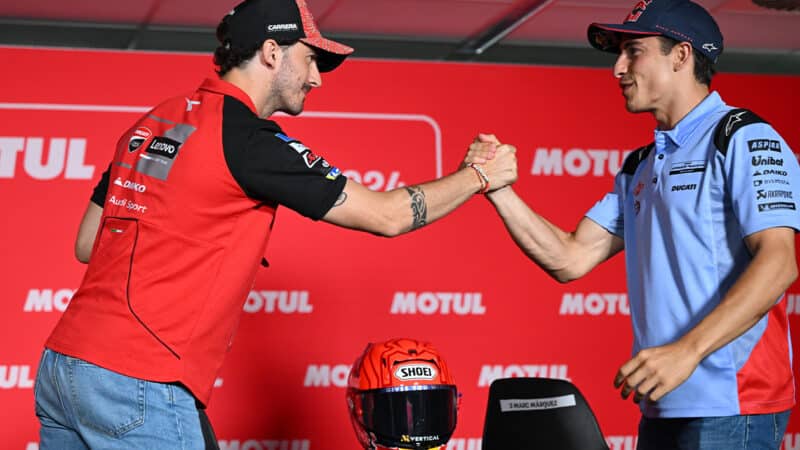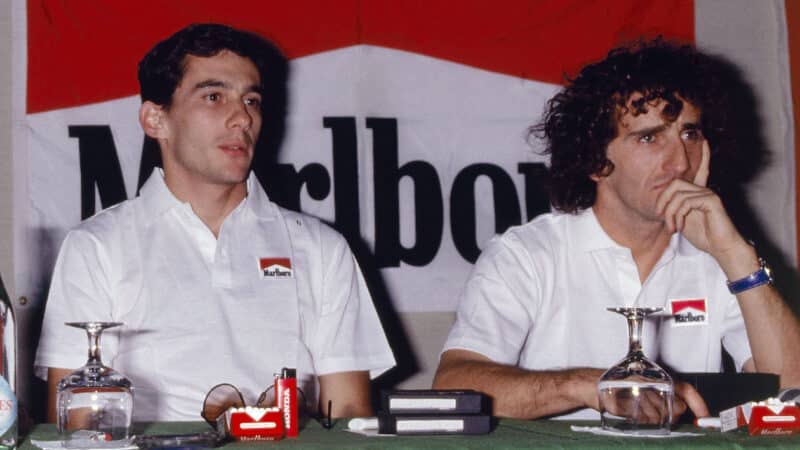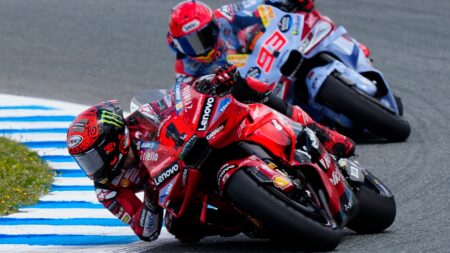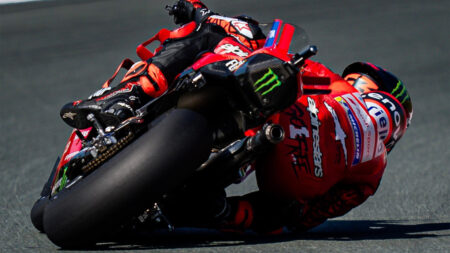All we can do is look to the past for possible answers. And we are lucky to have arguably the greatest tale of motor sport history to give us some pointers.
In the late 1980s two of the all-time greatest Formula 1 drivers drove for the team that had the fastest cars on the grid, while both drivers had similarly contrasted approaches to racing.
Yes, this was F1, and we should be mindful of the fact that wheel-to-wheel racing and collisions are very different on four wheels and two.
But, also, this was F1 at a time when it had much more of an affinity with motorcycle racing. The championship had yet to turn into what it is today: the Kardashians go motor racing.
First there was Alain Prost, nicknamed the professor for his super-calculated approach to racing. In other words, a 1980s, four-wheel version of Bagnaia.
Then there was Ayrton Senna, nicknamed by ‘Magic Senna’. In other words, Magic Marc Márquez is a 21st century reincarnation of the Brazilian genius, sharing the same spiritual attachment to victory.
The similarities couldn’t be more striking.
When McLaren put Prost and Senna in the same team at the start of 1988, many thought team boss Ron Dennis was mad, just like some think Gigi Dall’Igna and Davide Tardozzi are mad now. Because the Bagnaia, Márquez and Ducati combination is every bit as explosive a mixture as was Prost, Senna and McLaren.
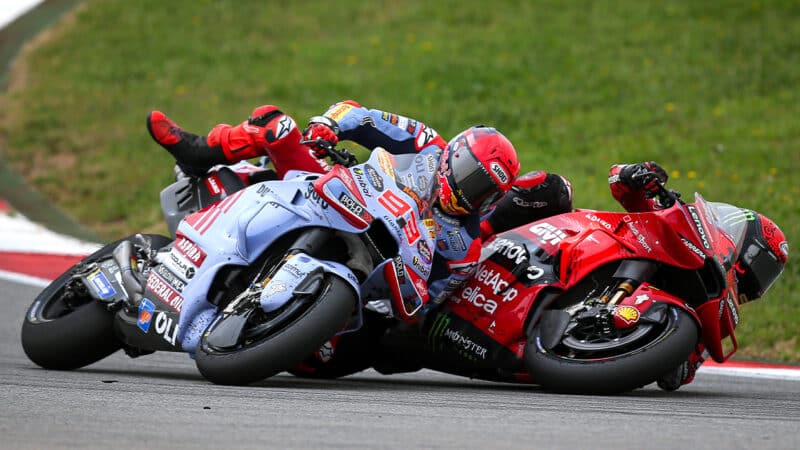
Márquez and Bagnaia collide and crash during this year’s Portuguese GP
Diogo Cardoso/DeFodi via Getty
Perhaps that was part of the attraction to Dennis and perhaps that is part of the attraction to Tardozzi and Dall’Igna, who are the Marc Márquez characters of pitlane – victory must be achieved and the ends will always justify the means.
Who wants a number one and a number two in the team when you can have two number ones and watch them fight it out, writing a story that will never be forgotten? It’s the kind of challenge for which only the brave will sign up to, which includes Ducati management.
Like Dennis, Dall’Igna and Tardozzi will need to use all their intelligence and Machiavellian skills to control a highly volatile situation and channel that volcanic power into total domination instead of total meltdown.
Ducati is dropping a bomb on MotoGP and it needs to make sure the bomb doesn’t blow up in its face.
Prost had already won two F1 titles with McLaren when Senna arrived in 1988. Like Bagnaia now, Prost knew trouble might be ahead
“Alain was fine with the competition [of Senna], but deeply suspicious too,” says Dennis, recalling the moment Senna arrived at McLaren. “Alain said, ‘Let’s just wait and see – this is going to be difficult’.”
He wasn’t wrong.
Senna and Prost had two seasons together at McLaren. In 1988 the pair won 15 of 16 GPs, Senna taking the title with eight wins to Prost’s seven. Their 1989 duel went down to the penultimate race at Suzuka, Japan, where Senna needed to win to keep his title hopes alive.
When Senna attacked Prost at Suzuka’s dead slow chicane the pair collided. Did Prost run his rival off the track on purpose? That depends on who you talk to. Anyway, the title went to Prost: one-all.
The crowning/ugliest moment of their rivalry happened at the end of 1990, when Prost was at Ferrari.
Once again they were duelling for the title and once again at the penultimate race at Suzuka. The mathematics told Senna that he would be champ if both failed to finish, so at the very first corner he dived inside Prost, taking them both out.
Dennis has no doubt he did it on purpose, “I looked at the [data] traces [from Senna’s car], the brake and the throttle pedals, and you didn’t need to be Einstein to work out what had happened”.
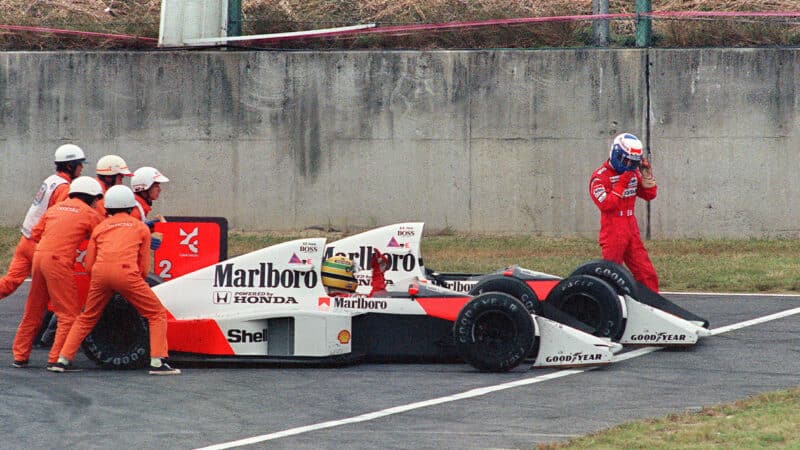
Prost (out of his car) and Senna after the 1989 Suzuka collision – they did the same a year later, at much higher speed
Toshifumi Kitamura/AFP via Getty Images
Two weeks after the second Prost/Senna Suzuka incident – which made headlines around the world and has become arguably the biggest moment in racing history – Senna took part in perhaps the greatest interview since engines and wheels first turned in anger.
The interview, recorded during the weekend of the 1990 season-ending Australian GP, is impossible to watch without imagining Márquez sitting there instead of Senna.
And the highlight of the interview is so exceptional it’s worth repeating, word for word.
“You should know that by being a racing driver, you are under risk all the time”
The questions were posed by retired three-times F1 champion Sir Jackie Stewart, who, like many older F1 types, was shocked by Senna’s muscular, take-no-prisoners driving style.
“Let me ask you another difficult question,” says Stewart as Senna bristles in his seat. “If I were to count back all the world champions, the number of times that they made contact with other drivers, you in the last 36 months or 48 months have been in contact with more drivers than they might have done in total.”
Senna responds with ice-cold rage.
“I find it amazing for you to make such a question, Stewart, because you are very experienced and you know a lot about racing,” he says. “And you should know that by being a racing driver, you are under risk all the time.
“Being a racing driver means you are racing with other people. And if you no longer go for a gap that exists, you’re no longer a racing driver, because we are competing. We are competing to win, and the main motivation for us is to compete for victory; it’s not to come third, fourth, fifth or sixth….
“F1 is competition at a very high level, with cars going so close, with the same horsepower, with the same level of grip, with the same [downforce] load.
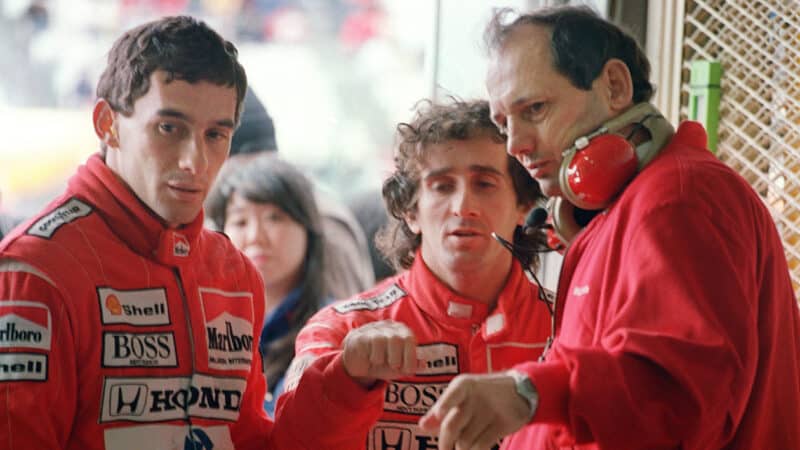
Senna and Prost with team boss Dennis – next year this will be Márquez, Bagnaia, Dall’Igna and Tardozzi
Kazuhiro Nogi/AFP via Getty Images
“We all know it is very difficult to overtake, because the circuits aren’t designed in an appropriate manner for overtaking manoeuvres, so you either commit yourself as a professional racing driver, who is designed to win races, or you come second, or you come third, or you come fifth.
“I race to win as long as I feel it’s possible. Sometimes you get it wrong. Sure, it’s impossible to get it right all the time. But I race, I am designed to win.”
It’s a superb interview, the like of which you may never see again, because the interviewer goes for the jugular and the interviewee doesn’t duck.
Bagnaia and Márquez seem to be – let’s say – professional friends at the moment. That will surely change when Márquez arrives in the factory garage in November and starts doing what he does, which is working to shift the engineering focus towards his side of the garage, just as Senna did when he arrived at McLaren.
Indeed Honda – which supplied engines to McLaren – admitted that it did favour Senna, because its engineers were in thrall to his style of driving and winning.
